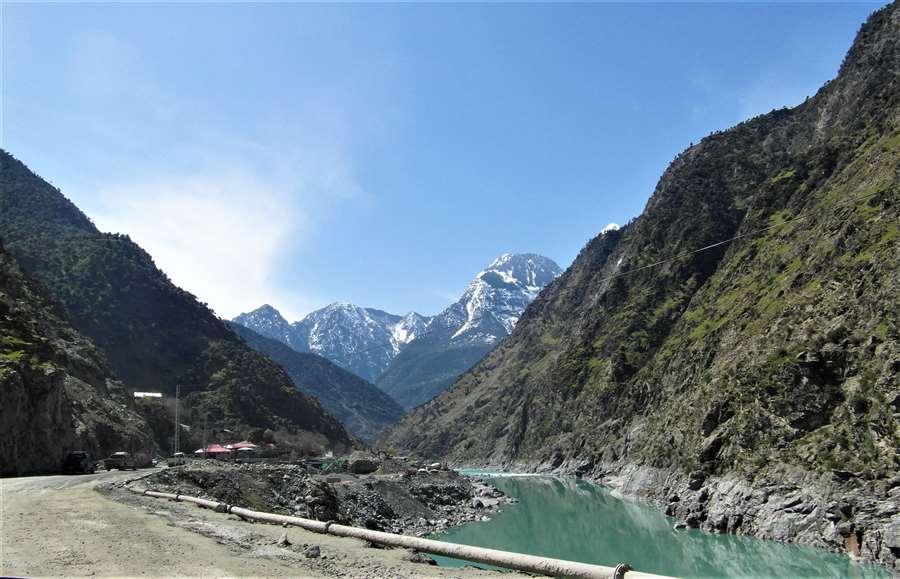R.E.News International-Pakistan secures US$1bn loan for hydropower project
 17/06/24-FR-English-NL-footer
17/06/24-FR-English-NL-footer
Le Pakistan obtient un prêt d'un milliard de dollars pour un projet hydroélectrique
 A pipeline runs through the Dasu Dam and hydropower plant site in Pakistan. (Image: Tractebel)
A pipeline runs through the Dasu Dam and hydropower plant site in Pakistan. (Image: Tractebel)
La Banque mondiale – une institution financière internationale qui accorde des prêts et des subventions pour des projets d’investissement aux pays à revenu faible ou intermédiaire – prêtera au Pakistan 1 milliard de dollars pour construire la plus grande centrale hydroélectrique du pays près de Dasu, dans la région nord de la province de Khyber Pakhtunkhwa.
Située sur le barrage de Dasu, alimenté par le fleuve Indus, la centrale hydroélectrique de Dasu devrait produire 21 TWh (térawattheures) par an avec une capacité installée de 4 320 MW (mégawatts).
Le barrage lui-même est une conception gravitaire en béton compacté au rouleau, qui peut retenir jusqu'à 1,4 milliard de mètres cubes (370 milliards de gallons) d'eau.
Le prêt s'ajoute aux 588 millions de dollars initialement accordés par la Banque mondiale au projet pour les travaux préparatoires et s'ajoute également à un autre prêt de 700 millions de dollars accordé en 2020 pour les travaux de lignes de transport.
Au total, la Banque mondiale a financé environ 2,3 milliards de dollars sur les 4,3 milliards de dollars du projet. Un financement supplémentaire provenait d'un consortium de banques locales et d'un financement commercial étranger de la Banque Crédit Suisse. L’Autorité de développement de l’eau et de l’électricité du pays s’est également engagée à financer 15 % du coût de base du projet.
Des décennies de développement pour le barrage de Dasu
Le chemin a été long pour faire avancer le projet de barrage et d’hydroélectricité, initialement proposé en 2001, avec une étude de faisabilité achevée en 2009.
Il est construit en deux phases, chaque étape achevée permettant une capacité de production d’électricité de plus de 2 000 MW. Une fois les deux phases terminées, on estime que la première phase apportera plus de 12 milliards d’unités d’électricité par an, tandis que la seconde sera capable de fournir neuf millions d’unités supplémentaires.
Même si cela fait plus de 20 ans, le Pakistan est toujours en bonne voie pour achever le projet à temps l’année prochaine, ce qui était son objectif déclaré au départ. Elle espère toujours que la production d’électricité pourra démarrer dans la centrale dès le second semestre 2024.
Les premiers travaux préparatoires ont eu lieu en 2014, les contrats pour les travaux préparatoires ont été attribués en 2015 et la construction a débuté en 2017.
China Gezhouba Group Company Limited est le principal entrepreneur en travaux et travaux de génie civil et a commencé la construction en 2018.
Une coentreprise de GE Hydro China et Power China Zhongnan Engineering Corporation a signé la construction en 2020, assurant la conception, la fourniture et l'installation de six turbines Francis, générateurs, transformateurs principaux, générateur et appareillage de commutation de service de station ainsi que les équipements associés.
Le projet hydroélectrique de Dasu semé d'embûches
Même si le projet repose sur plus de deux décennies de coopération internationale, avec des entreprises pakistanaises et chinoises travaillant en collaboration sur la construction, au moins deux incidents très médiatisés ont eu lieu sur le chantier de construction depuis 2021.
En juillet 2021, 13 ouvriers chinois et pakistanais du projet ont été tués lorsqu'un bus transportant ces travailleurs a été attaqué par une détonation explosive. Le bus est tombé dans un ravin après l'explosion. 28 autres personnes ont été blessées. Des membres des talibans pakistanais ont été accusés d'être responsables de l'attaque et arrêtés. Ils ont été condamnés à mort en 2022.
En mars de cette année, un autre bus transportant cinq ingénieurs chinois et un chauffeur pakistanais a été attaqué par un kamikaze, tuant les sept personnes impliquées. Aucun groupe n'a encore revendiqué la responsabilité de l'attaque.
NJC.© Info Banque Mondiale
--------------------------------------------------------------------------------------------------------------
 17/06/24-English
17/06/24-English
Pakistan secures US$1bn loan for hydropower project
 A pipeline runs through the Dasu Dam and hydropower plant site in Pakistan. (Image: Tractebel)
A pipeline runs through the Dasu Dam and hydropower plant site in Pakistan. (Image: Tractebel)
The World Bank – an international financial institution that awards loans and grants for capital projects to low- and middle-income countries – will lend Pakistan US$1 billion to construct the country’s largest hydropower plant near Dasu in the northern region of Khyber Pakhtunkhwa Province.
Located at the Dasu Dam, which is fed by the Indus River, the Dasu Hydropower Plant is projected to generate 21 TWh (terawatt hours) annually with an installed capacity of 4,320 MW (megawatts).
The dam itself is a gravity design made of roller-compacted concrete, which can reservoir up to 1.4 billionm3 (370 billion gallons) of water.
The loan is in addition to the original $588 million the World Bank lent the project for preparatory work and also on top of another $700 million loan delivered in 2020 for transmission line work.
Altogether, the World Bank has financed about $2.3 billion of the $4.3-billion project. Additional financing came from a consortium of local banks and foreign commercial financing from Credit Suisse Bank. The country’s Water & Power Development Authority is also committed to financing 15% of the project’s base cost.
Decades of development for Dasu Dam
It’s been a long road for the advancement of the dam and hydropower project, which was originally proposed in 2001, with a feasibility study completed in 2009.
It’s being constructed in two phases, with each completed stage allowing a capacity of more than 2,000MW of power generation. Once both phases are complete, it’s estimated the first phase will contribute more than 12 billion units of electricity annually while the second will be capable of providing another nine million units.
Although it’s been more than 20 years, Pakistan is still on track to complete the project on time next year, which was its stated goal at the onset. It still hopes power generation can commence at the plant as early as the second half of 2024.
Initial groundwork took place in 2014, and contracts for preparatory work were awarded in 2015, with construction starting in 2017.
China Gezhouba Group Company Limited is serving as the main works and civil works contractor and started construction in 2018.
A joint venture of GE Hydro China and Power China Zhongnan Engineering Corporation signed onto the build in 2020, providing design, supply, and installation of six Francis turbines, generators, main transformers, generator, and station service switchgear along with related equipment.
Dasu hydropower project fraught with conflict
Even though the project has more than two decades of international cooperation, with Pakistan and China firms working collaboratively on the build, at least two high-profile incidents have taken place at the construction site since 2021.
In July of 2021, 13 Chinese and Pakistani labourers for the project were killed when a bus transporting those workers was attacked by an explosive detonation. The bus fell into a ravine after the explosion. An additional 28 people were injured. Members of the Pakistani Taliban were blamed for the attack and arrested. They were sentenced to death in 2022.
In March of this year, another bus transporting five Chinese engineers plus a Pakistani driver was attacked by a suicide bomber, with all seven persons involved killed as a result. No group has yet taken responsibility for the attack.
NJC.© Info the World Bank
------------------------------------------------------------------------------------------------------------------
 17/06/24-NL
17/06/24-NL
Pakistan krijgt een lening van 1 miljard dollar voor een waterkrachtproject
 A pipeline runs through the Dasu Dam and hydropower plant site in Pakistan. (Image: Tractebel)
A pipeline runs through the Dasu Dam and hydropower plant site in Pakistan. (Image: Tractebel)
De Wereldbank – een internationale financiële instelling die leningen en subsidies verstrekt voor kapitaalprojecten aan lage- en middeninkomenslanden – zal Pakistan 1 miljard dollar lenen voor de bouw van de grootste waterkrachtcentrale van het land nabij Dasu in de noordelijke regio van de provincie Khyber Pakhtunkhwa.
De Dasu-waterkrachtcentrale, gelegen aan de Dasu-dam, die wordt gevoed door de rivier de Indus, zal naar verwachting jaarlijks 21 TWh (terawattuur) genereren met een geïnstalleerd vermogen van 4.320 MW (megawatt).
De dam zelf is een zwaartekrachtontwerp gemaakt van met rollen verdicht beton, dat tot 1,4 miljard m3 (370 miljard gallons) water kan opslaan.
De lening komt bovenop de oorspronkelijke 588 miljoen dollar die de Wereldbank aan het project heeft geleend voor voorbereidende werkzaamheden en komt bovenop nog een lening van 700 miljoen dollar die in 2020 werd verstrekt voor werkzaamheden aan de transmissielijn.
In totaal heeft de Wereldbank ongeveer 2,3 miljard dollar van het 4,3 miljard dollar kostende project gefinancierd. Aanvullende financiering kwam van een consortium van lokale banken en buitenlandse commerciële financiering van Credit Suisse Bank. De Water & Power Development Authority van het land heeft zich er ook toe verbonden 15% van de basiskosten van het project te financieren.
Tientallen jaren van ontwikkeling voor Dasu Dam
Het is een lange weg geweest voor de voortgang van het dam- en waterkrachtproject, dat oorspronkelijk in 2001 werd voorgesteld en waarvan de haalbaarheidsstudie in 2009 werd afgerond.
Het wordt gebouwd in twee fasen, waarbij elke voltooide fase een capaciteit van meer dan 2.000 MW aan energieopwekking mogelijk maakt. Zodra beide fasen zijn voltooid, wordt geschat dat de eerste fase jaarlijks meer dan 12 miljard eenheden elektriciteit zal opleveren, terwijl de tweede fase nog eens negen miljoen eenheden zal kunnen leveren.
Hoewel het al meer dan twintig jaar geleden is, ligt Pakistan nog steeds op koers om het project volgend jaar op tijd af te ronden, wat aanvankelijk het doel was. Het hoopt nog steeds dat de energieopwekking al in de tweede helft van 2024 in de centrale kan beginnen.
De eerste grondwerkzaamheden vonden plaats in 2014 en de contracten voor voorbereidende werkzaamheden werden in 2015 gegund en de bouw startte in 2017.
China Gezhouba Group Company Limited fungeert als de belangrijkste aannemer voor werken en civiele werken en is in 2018 met de bouw begonnen.
Een joint venture van GE Hydro China en Power China Zhongnan Engineering Corporation tekende in 2020 voor de bouw en verzorgde het ontwerp, de levering en de installatie van zes Francis-turbines, generatoren, hoofdtransformatoren, generator- en stationsbedieningsschakelapparatuur, samen met de bijbehorende apparatuur.
Dasu-waterkrachtproject vol conflicten
Hoewel het project al meer dan twintig jaar internationaal samenwerkt, waarbij bedrijven uit Pakistan en China samenwerken aan de bouw, hebben er sinds 2021 minstens twee spraakmakende incidenten plaatsgevonden op de bouwplaats.
In juli 2021 kwamen 13 Chinese en Pakistaanse arbeiders voor het project om het leven toen een bus die deze arbeiders vervoerde, werd aangevallen door een explosieve ontploffing. De bus viel na de explosie in een ravijn. Nog eens 28 mensen raakten gewond. Leden van de Pakistaanse Taliban kregen de schuld van de aanval en werden gearresteerd. In 2022 werden ze ter dood veroordeeld.
In maart van dit jaar werd een andere bus, waarin vijf Chinese ingenieurs en een Pakistaanse chauffeur zaten, aangevallen door een zelfmoordterrorist, waarbij alle zeven betrokkenen omkwamen. Nog geen enkele groep heeft de verantwoordelijkheid voor de aanval op zich genomen.
NJC.© Info de Wereldbank
-----------------------------------------------------------------------------------------------------------------
Date de dernière mise à jour : 14/06/2024

















